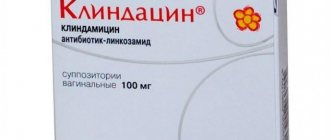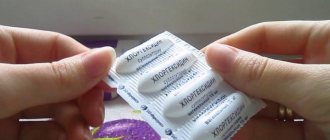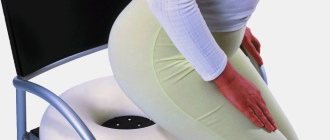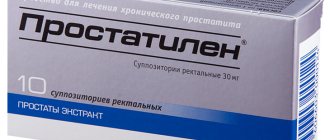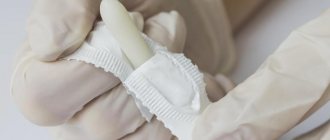Longidaza suppositories are a medicine with a fairly wide range of effectiveness. This medication is used as an anti-inflammatory drug and immunomodulator.
Longidaza is a medicine that has protein-dissolving activity. Roughly speaking, it promotes the breakdown of local inflammatory products that are of protein origin.
This work is ensured by the presence of the active component of the drug - an artificially produced hybrid molecule of dissolving enzymes.
Description of the drug
Longidase is an artificially synthesized chemical compound of hyaluronidase (a proteolytic enzyme) with a high molecular weight carrier that has pronounced immunomodulatory activity.
Instructions for use of Longidaza in the form of suppositories inform about the high enzymatic activity of the substance on the body for a long time. The drug is used for a progressive increase in the number of connective tissue cells, which entails their massive proliferation in different organs.
Recommendations from experts
Observing the statistics of treatment of cystitis with this drug, doctors noticed a decrease in pain effects and an increase in the volume of urination. The therapeutic effect lasted for six months. Throughout the course, excellent tolerability of the drug was noted along with minimal side effects. As a conclusion: “Longidaza” is a recommended remedy for patients with various forms of cystitis, specifically for the purpose of deviations caused by the disease.
Based on the results of completed courses of therapy for patients with adhesions, tube patency was identified in the pelvis. Further observation with a diagnosis of infertility revealed pregnancy in 70% of cases.
Candle release form, price
The drug is available in the form of torpedo-shaped suppositories of a yellowish-white color with possible marbling elements. They are packed in contour cellular plastic packaging of 5 candles. Boxes are packed in 5, 10, 20 pcs.
The cost of the drug in the form of a suppository varies from 1,700 to 2,200 rubles.
pharmachologic effect
The active substance of the drug Longidaza is characterized by long-acting enzymatic and proteolytic activity.
It has the following types of effects on the body:
- chelating;
- antioxidant;
- immunomodulatory;
- anti-inflammatory, moderate severity.
The duration of the effect of the enzyme is due to the fact that it is covalently combined with a high molecular weight carrier, which has its own medicinal activity.
Longidaza demonstrates:
- antifibrotic effect;
- reduction of inflammation in the critical phase;
- corrective effect on the synthesis of inflammatory neurotransmitters;
- increased production of immunoglobulins to foreign antigenic microorganisms;
- strengthening the body's immunity to bacterial and viral diseases.
Glycosaminoglycans are a special substrate of hyaluronidase, which form the foundation of the connective tissue matrix. Due to decay, they change their main properties.
Happens:
- reducing the binding of water and metal cations;
- strengthening the permeability of tissue barriers;
- facilitating the movement of fluids between cells;
- increased elasticity of connective tissue;
As a result of multiple experiments (biochemical, immunological, histological), the beneficial properties of Longidase were revealed. It does not negatively affect healthy connective tissue cells, but only affects those affected by fibrosis.
The absence of mutagenic, embryotoxic, terratogenic or carcinogenic effects was also noted.
Complex therapy of chronic inflammation
At the first stage of treatment of a long-term inflammatory process in the uterus, antimicrobial therapy is required, for which a drug with optimal sensitivity to the identified microorganisms is selected. Only after this the following types of therapeutic effects are applied:
- hormone therapy to correct ovarian functions and restore the structure of the endometrium;
- metabolic therapy, providing restoration processes of the uterine mucosa;
- vascular treatment to improve blood flow through the uterine arteries;
- local immunocorrection in the endometrium;
- antifibrotic and anti-adhesive therapy that prevents the formation of intracavitary synechiae;
- physiotherapy.
Longidaza for chronic endometritis provides optimal anti-sclerotic and anti-fibrotic effects on endometrial tissue, therefore the drug is widely used in gynecology.
Indications for use
The use of the medicine is indicated for adults and children over 12 years of age for the following diseases:
- Chronic prostatitis.
- Female infertility of the tubo-peritoneal type.
- Fibrosis of lung tissue.
- Asherman's syndrome (tissue fusion in the uterine cavity).
- Increased healing time for wounds and injuries.
- Adhesive pathological processes in the pelvic organs.
- Cystitis caused by non-infectious inflammation of the protective lining of the bladder.
- Scleroderma limited type.
- Fibroplastic induration of the penis.
- Preventive use after surgical manipulations on the genitourinary system.
- Excessive proliferation of benign prostate cells.
- Inflammation of the organs of the reproductive or excretory systems in a protracted form.
- Narrowing of the urethra and urinary tubes.
- Bacterial inflammation of the internal cavity of the uterus in an advanced form.
- Increasing the degree of absorption of antibacterial drugs.
Do not use by pregnant women and children under 12 years of age. During lactation, treatment with the drug must be agreed with the attending physician and justify the possible risks for the mother and child.
Nosological classification (ICD-10)
- A16 Respiratory tuberculosis, not confirmed bacteriologically or histologically
- J84.1 Other interstitial lung diseases with mention of fibrosis
- J84.8 Other specified interstitial pulmonary diseases
- K66.0 Peritoneal adhesions
- L08.0 Pyoderma
- L90.5 Scar conditions and fibrosis of the skin
- L91.0 Keloid scar
- L91.9 Hypertrophic skin change, unspecified
- L94.0 Localized scleroderma
- M19.9 Arthrosis, unspecified
- M24.5 Joint contracture
- M45 Ankylosing spondylitis
- N30.1 Interstitial cystitis (chronic)
- N41.1 Chronic prostatitis
- N71 Inflammatory diseases of the uterus, except the cervix
- N85.6 Intrauterine synechiae
- N97.1 Female infertility of tubal origin
- N99.4 Postoperative adhesions in the pelvis
- T14.0 Superficial injury to unspecified body area
- T14.1 Open wound of unspecified body area
- T30 Thermal and chemical burns of unspecified location
- Z100* CLASS XXII Surgical practice
- Z100.0* Anesthesiology and premedication
Instructions for use
Longidaza is a suppository in gynecology, the instructions for which contain information on dosages and methods of use depending on the diagnosis.
There are several main dosage regimens:
- For skin and venereal diseases (scleroderma, acne, keloid scars, pyoderma), use one suppository with an interval of 1-2 days in a cycle of 10-15 doses. Administration is rectal.
- For gynecological pathologies (endomyometritis, adhesions in the uterine cavity, inflammation of the fallopian tubes, ovarian cysts, infertility) and after operations, rectal or intravaginal administration of one suppository every 2 days in a cycle of 10 doses is indicated.
- In case of defective lung tissue (fibrosis, tuberculosis, pneumosclerosis, siderosis, pleurisy), it is necessary to apply 1 suppository rectally every 2-4 days in a cycle of 10-20 doses.
- Therapy of the excretory system (prostatitis, chronic cystitis, urethritis) consists of a course of rectal administration of 20 doses of the drug. 1 suppository every other day for 20 days, then a similar dosage, but with an interval of 2-3 days.
After completing the therapeutic course of using Longidase, two scenarios are possible:
- The first is the further introduction of suppositories in one dose every 6-7 days as preventive measures for no more than 4 months.
- Second, if it is necessary to repeat an intensive course, the break between them should be 3 months.
- The doctor, based on the patient’s medical history, can change the dosage regimen and dosage of the medication.
Important! Administration of suppositories should occur in a supine position. Hygienic care must be taken before insertion. And with rectal administration, bowel cleansing is important.
Reviews
Elena, 32 years old: “A year ago I was diagnosed with endometritis. I used Longidaza suppositories once every three days for 2 months. Inserted vaginally. The ultrasound specialist noticed the effect within a month, and after two months the inflammatory process practically stopped. Three months later I took a second course, after which I was completely cured. I recommend this drug to anyone who wants to quickly get rid of reproductive system problems.”
Anastasia, 23 years old: “I was prescribed suppositories after uterine surgery. There was a high likelihood of negative scarring. I took three courses of 30 days each with a break of 2.5 months. At first, the effect was difficult to notice: healing had just begun. The drug often made me feel dizzy. But by the third round it was already noticeable that the recovery had gone as it should. After the last course, the risk of adhesions completely disappeared. “I am grateful to the doctor for saving me from possible complications and infertility by prescribing Longidaza.”
Use for renal impairment
A history of evidence of serious impairment or complete cessation of kidney function should prohibit the use of Longidase.
In case of moderate renal failure, it is permissible to use the medicine no more than 1 suppository per week, under the supervision of a doctor.
special instructions
When using Longidase during an exacerbation of chronic or acute infectious processes in the body, it is necessary to cover it with antimicrobial drugs.
If you have an allergic reaction to Longidaza, its use should be stopped immediately. It is prohibited to inject Longidase solution into the site of acute inflammation, infectious skin lesions or tumors.
In patients with renal failure, Longidaza is prescribed in a dosage no more than once a week. Available in pharmacies without a prescription.
Use in children
It is prohibited to prescribe in children under 12 years of age, due to the lack of reliable clinical studies of the effect on this category of persons. Treatment regimens similar to adults are recommended for children 13-18 years old. Dosages also remain unchanged. Rectally or vaginally, before bedtime, apply 3000 IU of the drug with an interval of 24-72 hours, in a cycle of 10 to 15 doses.
The interval depends on the organ system in which the pathological process is observed. In severe cases of the disease, the doctor can adjust the course, increasing the intensity of the dosage regimen.
Risk factors for developing pathology
The abdominal cavity is covered inside with a specific membrane consisting of two sheets.
If damaged, they can stick together, forming adhesions. This is a kind of adaptation mechanism of the body, the main purpose of which is to distinguish inflamed areas from healthy ones. The tendency to develop pathology and the level of its manifestation are individual and depend on many reasons, for example, heredity. The main prerequisites for the appearance of adhesions, established by medicine at the present time, are excessive activity of the connective tissue membrane and a decrease in the body’s immune forces.
Risk factors for the disease also include:
- surgical interventions, especially repeated ones;
- sexually transmitted diseases;
- internal bleeding;
- complications during pregnancy, labor, abortion, use of an intrauterine device;
- endometriosis;
- pathology of the connective tissue membrane.
Most cases of adhesions occur under the combined influence of negative factors.
Longidaza for endometriosis
Endometriosis is considered a common, but nevertheless dangerous disease. If the diagnosis is not made in a timely manner and there is no proper treatment, the disease can take a chronic form and provoke complications such as infertility.
With endometriosis, the layer of cells that lines the inside of the uterus grows. As a result, clusters are formed - peculiar tissue nodules that penetrate into neighboring organs.
To prevent the progression of the disease, in the treatment of cysts and tubal obstruction of the uterus, doctors prescribe the drug Longidaza. The drug is characterized by high enzymatic activity and a prolonged effect on the body. Longidaza exhibits antifibrotic properties, that is, accumulations of connective tissue appear slowly or their formation stops. Therefore, the medicine can increase the body’s resistance to infection.
Existing modified protein structures are broken down, the degree of viscosity in tissues becomes lower, due to which the permeability of tissue barriers and their elasticity increases, and fluid circulates better. This is manifested in the body by a decrease in edema, a significant flattening of scar tissue and leveling of the adhesive process.
Longidase does not damage normal connective tissue; the drug destroys only structurally and modified tissue in the area of fibrous accumulations. At the same time, Longidase does not have carcinogenic, teratogenic, embryotoxic or mutagenic properties. According to studies, in general, patients tolerate the drug well. If the dosage and rules of administration are followed, allergic reactions, as a rule, are not observed.
The medication does not slow down the recovery of patients after surgery, does not inhibit bone regeneration and wound healing. In addition to the main active ingredient, the vaginal suppository contains cocoa butter, which helps transport the medicinal component into the body.
Gynecologists usually prescribe Longidase for endometriosis in the form of suppositories, thus reducing the likelihood of an allergic reaction. Suppositories are used either rectally (through the rectum) or intravaginally (suppositories are inserted into the vagina).
The rectal method of application is usually recommended for older people, people under 18 years of age, and patients with severe renal failure. In all other cases, the vaginal method is used. There is a standard generally accepted treatment regimen:
- 1 suppository is administered every two days. It is necessary to complete a course of at least 10 applications. This is the treatment stage;
- maintenance therapy may be indicated in a specific case, it is prescribed if necessary (in such cases, the general course may consist of 15-20 applications);
- in some cases, if the patient has other diseases, the drug regimen may need to be adjusted. You may need 7 to 10 injections from 3000 IU vials. But less often than usual - one every 4-5 days;
- in case of residual effects or recurring cases of endometriosis in the patient, the next course of Longidase is possible only after 2 months.
Vaginally, Longidaza suppositories are administered in a lying position. For the patient’s convenience, this procedure is performed at night. In order not to interrupt treatment during menstruation and thereby not negate the effectiveness, suppositories are administered rectally on menstruation days.
If suppositories are used in this way, then before use it is necessary to clean the rectum using a regular enema or microenema with a ready-made solution.
When treating endometriosis with Longidaza, it is important to consider some points:
- to prevent the active spread of infection, the drug should be combined with antibiotics;
- if even a mild allergy occurs, you must immediately inform your doctor;
- If a drug dose is missed for some reason, you must continue treatment according to the regimen prescribed by your doctor. It is impossible to double the dose in an attempt to compensate for the omission;
- The dosage of the drug is observed until discontinuation. There is no need to gradually reduce the amount of the product.
When using candles, they need to be checked for color changes and the integrity of the packaging. If the packaging was accidentally damaged, it is not recommended to use suppositories.
Drug interactions
Longidaza is a suppository for gynecology, the instructions for which contain information about interactions with other medications, based on clinical studies of the active component.
Bovhyaluronidase azoximer (the main active ingredient of the drug) can be safely combined with bronchodilator tablets and syrups. The medicine can also be used in conjunction with drugs with antibacterial, antifungal and antiviral effects. This gives doctors the opportunity to prescribe this drug as a component of complex therapy.
In addition to its beneficial properties, Longidaza is able to increase bioavailability and enhance the effect of other medications.
If the drug is used in combination with antihistamines, cortisone and drugs containing estrogen, its effectiveness is somewhat reduced. The drug should not be used in conjunction with drugs that have a diuretic effect.
A decrease in the effect of the active enzyme was revealed in individuals taking large doses of:
1. NSAID medications based on salicylates (esters of salicylic acid):
- aspirin;
- anacin;
- citramon;
- Excedrin;
- Ambien;
- apizarthron;
- aspizol and others.
2. Hormone of the adrenal cortex cortisone (drug Cortisone).
3. Corticotropins - hormonal drugs:
- exactin;
- ACTH-zinc phosphate;
- procortan-D and others.
4. Estrogen-based drugs:
- estriol;
- climate;
- microfollin;
- estrimax;
- ovepol and others.
5. Antihistamines:
- tavegil;
- fenkarol;
- zodak;
- Semprex;
- Zyrtec;
- cetrin;
- levocetirizine;
- xysal;
- erius.
It is important to know! When using Longidase in combination treatment, the possibility of increasing or decreasing single bioavailability, as well as the degree of increasing or decreasing systemic action, should be taken into account.
Analogs
The following drugs are generics of Longidase:
- Polyoxidonium, Petrovax Pharm NPO (Russia) – tablets, suppositories, ampoules. The cost of tablets is 640 rubles; ampoules – 1000 rub.; suppositories – from 700 rub.
- Lidaza, Samson-Med (Russia) – powder or ampoules for injection. Cost from 15 rub. per ampoule.
- Dimephosphon, Technofos (Russia) – solution for external or internal use. The cost of the bottle is 285 rubles.
- Pulsacilla, Biologische Heilmittel Heel GmbH (Germany) – homeopathic remedy in granules for internal use. The cost starts from 100 rubles. and changes with increasing dosage and volume.
- Lidaza M, MicroGen – lyophilisate for injection. The price starts from 245 rubles. per pack of 10 ampoules.
- Laprot, NT Pharma LLC "Medgamal" - powder for injection. Price - 4000 rub.
Medicinal properties of Longidase
An enzyme medicine in the form of vaginal or rectal suppositories has many beneficial properties that will help the doctor cope with the consequences of endometritis. The optimal therapeutic effect is ensured by the following properties:
- antifibrotic (preventing the formation of new fibrous adhesions);
- anti-sclerotic (reducing the severity of sclerotic processes in the endometrium);
- anti-inflammatory (reducing the inflammatory response of tissues);
- decongestant (elimination of local tissue edema caused by chronic inflammation);
- antioxidant (prevents the destruction of endometrial cells);
- immunocorrective (improving local immune reactions).
The versatility of the positive effects of suppositories helps prevent serious complications of the chronic inflammatory process - infertility and pelvic pain syndrome caused by adhesions.
Precautionary measures
When treating with Longidase, you must carefully monitor your own condition and the course of the disease in order to prevent undesirable consequences.
The precautions in this case are:
- Complete cessation of drug administration if an allergic reaction occurs until its cause is determined.
- You should not use a medicine that has been stored incorrectly (in a damp place with high temperature).
- If you miss another suppository, you should not administer a double dosage. It is necessary to continue to strictly follow the dosage regimen prescribed by the doctor.
- If a bacterial infection occurs during therapy, then in addition to Longidase, the use of antimicrobial drugs (antibiotics) is necessary. This will stop it from spreading throughout the body.
- You should refuse to use suppositories if, upon opening the package, they do not correspond to the declared appearance (have a different color, consistency, smell).
Side effects
In general, the drug was well tolerated by patients; no local or general allergic reactions were noted. The instructions inform about the only side effect that was identified during clinical trials of suppositories in gynecology.
This is a local allergic response to the active substance:
- burning or itching sensation;
- redness;
- swelling of the skin;
- allergic urticaria.
Longidaza suppositories can cause allergic urticaria.
Important! It is worth taking into account individual physiological characteristics and the possibility of an adverse reaction not described in the package insert. In this case, you must stop taking the medication and visit a doctor to determine further actions.
Pharmacokinetics
The maximum effectiveness of Longidase in any form is achieved if treatment is started at an early stage of the pathological process. Longidase has an antioxidant effect due to the fact that the active substance is able to bind iron ions, which activate free radical reactions, stimulate hyaluronidase inhibitors and collagen synthesis.
The drug has pronounced antifibrotic effectiveness, which has been proven by many studies. Longidase can regulate the synthesis of inflammatory mediators, help stimulate humoral immunity and significantly weaken the acute phase of the inflammatory process.
Longidaza does not have a negative effect on bone and connective tissue, does not contribute to the development or intensification of the infectious-inflammatory process and can be safely used after operations as a prophylactic against adhesions and scar formation.
When using Longidase rectally, the active substance of the drug penetrates well into the systemic bloodstream. The maximum concentration of the drug in the blood is achieved within an hour. The bioavailability of Logidase during rectal or vaginal use reaches 70%.
Longidaza does not affect the functioning of the reproductive system and immunity, has low toxicity and does not have a mutagenic, teratogenic or carcinogenic effect on the human body. Longidase is able to penetrate the blood-brain, ophthalmological and hematoplacental barriers.
The absence of tissue cumulation was established. Its half-life when used in suppository form is approximately 42-84 hours. Longidaza is usually well tolerated by patients. When using it, practically no local or systemic allergic reactions are observed.
Contraindications
Longidase treatment is contraindicated in the following cases:
- bacterial infectious diseases in the acute stage of their course;
- the presence of heme in sputum during coughing attacks;
- pregnancy and breastfeeding;
- formations of carcinogenic type;
- severe renal failure;
- allergic response to one of the components of the drug;
- age (up to 12 years);
- eye purpura;
- bleeding in the lungs.
Who shouldn't
Despite the relative safety of Longidase and good tolerability, there are contraindications to the drug. These include the following:
- hypersensitivity to the components of the drug;
- bleeding from the lungs;
- vitreous hemorrhage;
- diagnosed oncological diseases;
- renal failure;
- not recommended during pregnancy and lactation.
USEFUL INFORMATION: Fallopian tubes are normal
Complications of taking
Reviews from doctors and women who have used the drug indicate the following possible side effects:
- pain - at the injection site when using injections;
- itching, redness, slight swelling - at the injection site or in the vulva and vaginal area.
